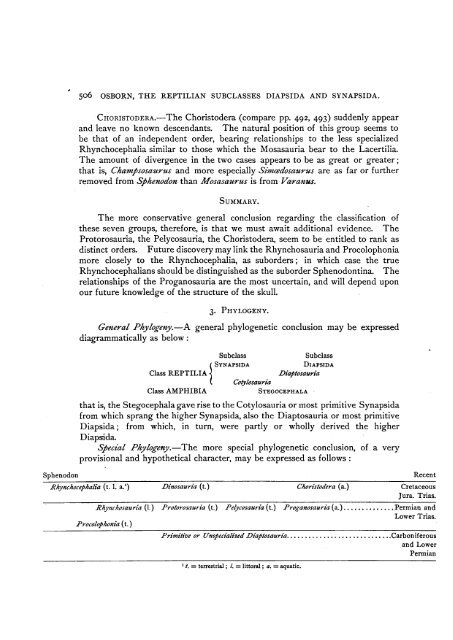American Museum of Natural History
American Museum of Natural History
American Museum of Natural History
You also want an ePaper? Increase the reach of your titles
YUMPU automatically turns print PDFs into web optimized ePapers that Google loves.
ol<br />
506 OSBORN, THE REPTILIAN SUBCLASSES DIAPSIDA AND SYNAPSIDA.<br />
CHORISTODERA.-The Choristodera (compare pp. 492, 493) suddenly appear<br />
and leave no known descendants. The natural position <strong>of</strong> this group seems to<br />
be that <strong>of</strong> an independent order, bearing relationships to the less specialized<br />
Rhynchocephalia similar to those which the Mosasauria bear to the Lacertilia.<br />
The amount <strong>of</strong> divergence in the two cases appears to be as great or greater;<br />
that is, Champsosaurus and more especially Simcedosaurus are as far or further<br />
removed from Sphenodon than Mosasaurus is from Varanus.<br />
SUMMARY.<br />
The more conservative general conclusion regarding the classification <strong>of</strong><br />
these seven groups, therefore, is that we must await additional evidence. The<br />
Protorosauria, the Pelycosauria, the Choristodera, seem to be entitled to rank as<br />
distinct orders. Future discovery may link the Rhynchosauria and Procolophonia<br />
more closely to the Rhynchocephalia, as suborders; in which case the true<br />
Rhynchocephalians should be distinguished as the suborder Sphenodontina. The<br />
relationships <strong>of</strong> the Proganosauria are the most uncertain, and will depend upon<br />
our future knowledge <strong>of</strong> the structure <strong>of</strong> the skull.<br />
3. PHYLOGENY.<br />
General Phylogeny.-A general phylogenetic conclusion may be expressed<br />
diagrammatically as below:<br />
Subclass Subclass<br />
(SYNAPSIDA DIAPSIDA<br />
Class REPTILIA Diaptosauria<br />
( Cotylosauria<br />
Class AMPHIBIA STEGOCEPHALA<br />
that is, the Stegocephala gave rise to the Cotylosauria or most primitive Synapsida<br />
from which sprang the higher Synapsida, also the Diaptosauria or most primitive<br />
Diapsida; from which, in turn, were partly or wholly derived the higher<br />
Diapsida.<br />
Special Phylogeny.-The more special phylogenetic conclusion, <strong>of</strong> a very<br />
provisional and hypothetical character, may be expressed as follows:<br />
Sphenodon Recent<br />
Rhynchocephalia (t. 1. a.') Dinosauria (t.) Choristodera (a.) Cretaceous<br />
Jura. Trias.<br />
Rhynchosauria (I.) Protorosauria (t.) Pelycosauria (t.) Proganosauria (a.) .............. Permian and<br />
Lower Trias.<br />
Procolophonia (t.)<br />
Primitive or Uns.pecialized Diaptosauria.............Carboniferous<br />
and Lower<br />
Permian<br />
't. = terrestrial; 1. = littoral; a. = aquatic.

















